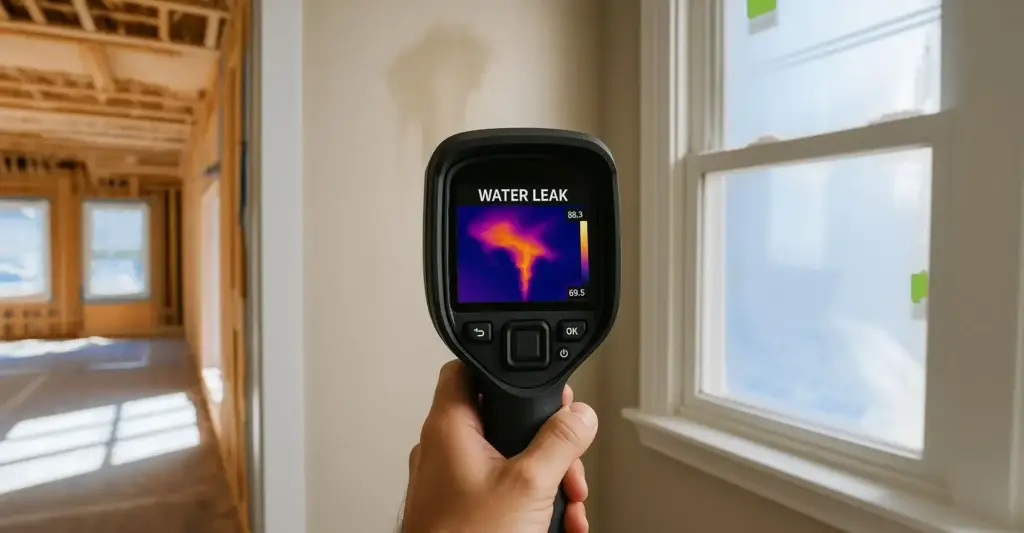Upon discovering a flooded basement, prioritise safety: immediately cut power (if safe) and stop the water source. Document all damage for insurance. For effective and safe water removal, especially for significant floods or contaminated water, contact professional flooded basement cleaning services like Ideal Response instantly. Swift professional intervention is crucial to prevent rapid mould growth (within 24-48 hours) and minimise long-term damage, as comprehensive drying and restoration can take weeks.
Skip to:
First steps after a basement flood
The cost of flooded basement cleaning in the UK
How long until my basement is dry?
What items can be saved after a flood?
Basement floods in UK property
Waking up to a flooded basement is a scenario no homeowner or commercial property manager ever wants to face. The sight of standing water, the smell of damp, and the immediate worry about damaged possessions and structural integrity can be overwhelming. Questions race through your mind: “What do I do first? How much will this cost? Is it safe to go down there? And how do I stop this from happening again?”.
At Ideal Response, we specialise in flooded basement cleaning services across the UK, providing rapid, efficient, and thorough solutions for both residential and commercial properties. We understand the urgency and the complex challenges a flooded basement presents. This comprehensive guide aims to answer your most critical questions, helping you navigate the aftermath of a basement flood with confidence and ensuring a complete, safe recovery.
What should be my absolute first steps when my basement floods?
Safety is paramount. Here’s a crucial checklist for immediate action:
- Prioritise safety: Do NOT enter the basement if there’s any risk of electrical shock (standing water near outlets/appliances) or if the water level is high enough to pose a drowning risk. If in doubt, stay out and call for help.
- Cut the power: If it’s safe to do so, turn off the electricity to your basement at your main fuse box. Water and electricity are a dangerous combination.
- Identify and stop the source (if possible): Is it a burst pipe? An overflowing appliance? A blocked drain? If you can safely access it, turn off the water supply to your home. For external flooding, you’ll need to wait for the water to recede or for professional help.
- Document the damage: Before moving anything or starting clean-up, take extensive photos and videos. This visual evidence is crucial for your insurance claim. Note the water level, damaged items, and the overall state.
- Contact your insurer: Report the flood to your insurance provider immediately. They can advise on your policy coverage and the next steps for a claim.
- Call the professionals: For significant flooding, a professional flooded basement cleaning service like Ideal Response is essential. We have the specialised equipment and expertise to handle the situation safely and effectively.
How do I get rid of the water quickly and safely? Can I use my own pump?
While a small domestic wet-vac or pump might seem appealing, for anything more than a shallow puddle, professional water removal for a flooded basement is critical. Here’s why:
- Speed and efficiency: Professional-grade submersible pumps can remove thousands of litres of water per hour, far exceeding domestic equipment. This rapid extraction minimises the time water sits, reducing further damage and mould risk.
- Safety: Our technicians are trained to work safely in flooded environments, understanding electrical hazards and contaminated water risks.
- Thoroughness: Simply pumping out visible water isn’t enough. Water will have seeped into walls, under flooring, and into concrete. Professionals use advanced moisture meters to detect hidden saturation.
- Contamination: Basement floodwater, especially from external sources or sewage, can be highly contaminated. Handling it requires appropriate personal protective equipment (PPE) and biohazard disposal procedures.
What’s the risk of mould after a basement flood, and how can I prevent It?
This is perhaps one of the biggest long-term concerns. Mould can begin to grow within 24-48 hours of water exposure. It not only causes unpleasant odours and damages property but can also pose significant health risks, especially for those with respiratory issues.
Prevention is key, and it relies on rapid and thorough drying. Our approach includes:
- Immediate drying: Once water is extracted, industrial-grade dehumidifiers and air movers are deployed to rapidly reduce humidity and extract moisture from structural materials.
- Antimicrobial treatments: We apply professional-grade antimicrobial agents to surfaces to inhibit mould and bacterial growth.
- Ventilation: Strategic ventilation helps air circulation and speeds up the drying process.
- Moisture monitoring: Continuous monitoring with specialised equipment ensures that all affected areas are dried to safe levels, preventing hidden mould growth.
Attempting to dry a basement yourself with domestic fans often leaves residual moisture, creating a perfect breeding ground for mould and the need for professional mould removal.
How much does flooded basement cleaning cost in the UK?
The cost of flooded basement cleaning in the UK is highly variable, depending on several key factors:
- Water category: As with any water damage, clean water (Category 1) is less expensive than grey (Category 2) or black (Category 3 – e.g., sewage backup or external floodwater) due to the level of contamination and required sanitisation.
- Depth and extent of flooding: The volume of water, the size of the basement, and how many items or structural elements are affected directly impact labour and equipment needs.
- Duration of water exposure: The longer the water has been standing, the greater the saturation, potential for mould, and complexity of the clean-up.
- Type of materials affected: Carpet, drywall, insulation, wood, and concrete all react differently to water and require specific drying or removal protocols.
- Debris removal: If there’s a significant amount of damaged debris or contaminated materials to remove and dispose of.
- Repairs and restoration: Beyond drying and cleaning, does the basement require structural repairs, new flooring, or re-plastering?
- Emergency response time: Urgent call-outs might have different pricing structures compared to scheduled clean-ups.
At Ideal Response, we provide a detailed, transparent quotation after a comprehensive assessment, ensuring you understand all aspects of the cost.
How long until my basement is dry and safe again?
There’s no single answer, but generally, the drying process for a flooded basement can take anywhere from 3 days to several weeks. Factors influencing this timeline include:
- Severity of the flood: The volume of water and the extent of saturation.
- Humidity levels: Higher ambient humidity slows drying.
- Materials: Dense materials like concrete take longer to dry than porous materials like plasterboard.
- Ventilation and equipment: Proper use of industrial-grade drying equipment significantly speeds up the process.
- Secondary damage: The presence of mould or significant structural damage will extend the overall recovery time.
We provide regular updates and use moisture mapping to show you the progress, ensuring your basement is certifiably dry and safe before we complete the job.
What items can be saved after a basement flood?
This depends heavily on the water’s category and the item’s material.
- Generally salvageable (with professional cleaning): Hard, non-porous items like metal, glass, certain plastics, and some treated wood furniture.
- Often unsatisfactory to save (especially with contaminated water): Porous materials like carpets (especially underlay), upholstered furniture, mattresses, drywall, insulation, paper, and untreated wood often need to be safely disposed of due to contamination risks and difficulty in thorough drying.
- Sentimental items: Even if an item is porous, if it holds extreme sentimental value, we can discuss specialist cleaning and restoration options.
How can I prevent my basement from flooding again?
Prevention is key to avoiding future basement floods:
- Sump pump maintenance: If you have one, ensure your sump pump is working correctly with a battery backup. Test it regularly.
- Proper drainage: Ensure your gutters and downspouts are clear and direct water away from your foundation. Consider extending downspouts.
- Exterior grading: Make sure the ground around your home slopes away from the foundation, not towards it.
- Seal cracks: Inspect your basement walls and floor for cracks and have them professionally sealed.
- Backflow valve: Install a backflow valve on your sewer line to prevent municipal sewer backups.
- Water-resistant landscaping: Avoid planting water-hungry plants near your foundation.
- Appliance maintenance: Regularly check hoses and connections for washing machines, water heaters, and dishwashers.
Conclusion: Don’t let a flooded basement become a lasting problem
A flooded basement is more than just an inconvenience; it’s a potential health hazard and a threat to your property’s value. By understanding the immediate steps, the importance of professional intervention, and preventative measures, you can protect your investment.
If your basement has flooded in the UK, don’t delay. The faster you act, the less damage and expense you’ll incur. Ideal Response offers 24/7 rapid response and expert flooded basement cleaning services. Call us today for immediate assistance and peace of mind or visit our flooded basement service page to learn more.
Need to speak to a specialist urgently? Call 01622 926 505
Flooded basement cleaning: Frequently asked questions
What are the absolute first steps when my basement floods?
Upon discovering a flooded basement, immediately prioritise safety:
Cut power at the fuse box if safe (do NOT enter if there’s electrical risk or deep water).
Stop the water source if possible (e.g., main water supply).
Document all damage with photos/videos for your insurer.
Contact your insurance provider immediately.
Call a professional flooded basement cleaning service, especially for significant or contaminated water.
Can I remove flooded basement water myself, or do I need professionals?
For anything more than a small, clean puddle, professional water removal is critical. Domestic equipment is often insufficient, leaving hidden moisture that leads to mould growth (within 24-48 hours). Professionals use industrial-grade pumps, advanced moisture meters, and handle contaminated water safely, ensuring thorough drying and mould prevention beyond DIY capabilities.
What is the risk of mould after a basement flood, and how is it prevented?
Mould is a significant risk, beginning to grow within 24-48 hours of water exposure. It causes odours, property damage, and health risks. Prevention relies on rapid and thorough drying, which professionals achieve using industrial dehumidifiers, air movers, antimicrobial treatments, and continuous moisture monitoring to ensure all affected areas are dried to safe levels.
How much does flooded basement cleaning cost in the UK?
The cost of flooded basement cleaning in the UK is highly variable, ranging from £10,000 to £50,000 (according to a 2007 Defra report, though inflation has increased this). It depends on:
Water category (clean, grey, or black/sewage).
Depth and extent of flooding.
Duration of water exposure.
Materials affected (e.g., carpet, drywall, concrete).
Need for debris removal or structural repairs. Professional services provide a detailed, transparent quotation after assessment.
How long does flooded basement restoration typically take?
The drying process for a flooded basement generally takes anywhere from 3 days to several weeks, or even months for extensive damage. The timeline is influenced by the flood’s severity, humidity, affected materials (dense materials like concrete take longer), and the effectiveness of industrial drying equipment. Professionals provide an estimated timeline and monitor progress.
hat items can be saved after a basement flood?
Generally, hard, non-porous items like metal, glass, certain plastics, and treated wood furniture can often be salvaged with professional cleaning. Porous materials (carpets, upholstered furniture, mattresses, drywall, insulation, paper, untreated wood) are often unsalvageable, especially with contaminated water, due to contamination risks and difficulty in thorough drying. Sentimental items can sometimes undergo specialist cleaning.
How can I prevent my basement from flooding again?
Key prevention measures include:
Regular sump pump maintenance (with battery backup).
Ensuring proper exterior drainage (clear gutters, downspouts directing water away from foundation, correct ground grading).
Sealing cracks in basement walls/floor.
Installing a backflow valve on sewer lines.
Regular appliance maintenance (washing machines, water heaters).
Considering water detection alarms.

Tahlia Ibrahim - Delivery Manager
Tahlia has over four and a half years of in-depth experience across various facets of the disaster recovery industry. Having progressed through roles in marketing and sales to her current position, Tahlia possesses a comprehensive understanding of the entire business operation, from initial client contact to meticulous service delivery. A certified BioSweep Specialist, she excels in advanced odour elimination techniques, ensuring thorough restoration.





















